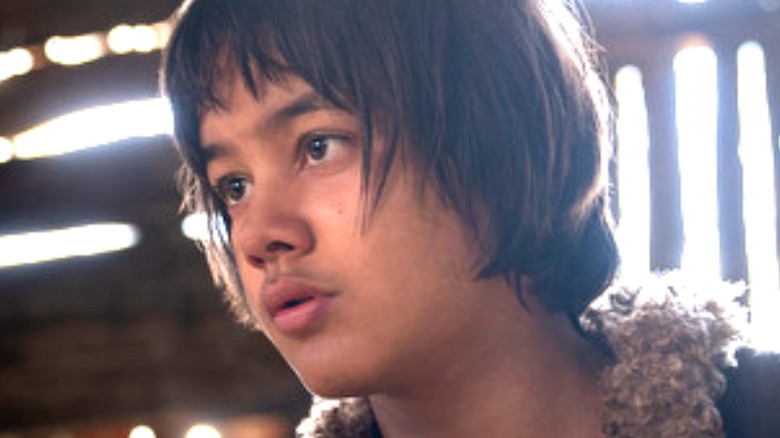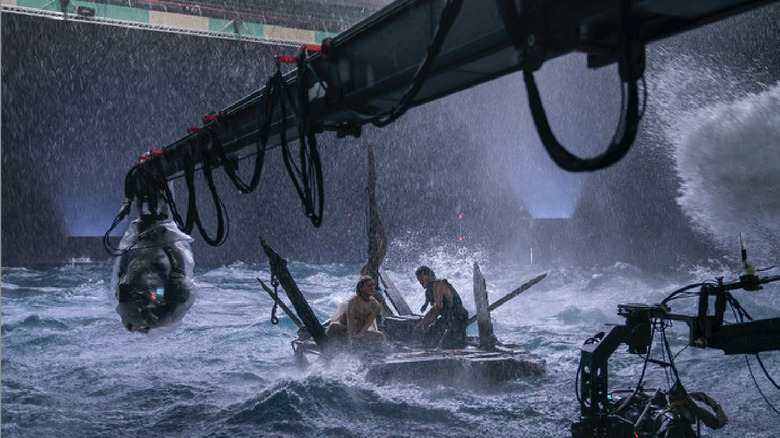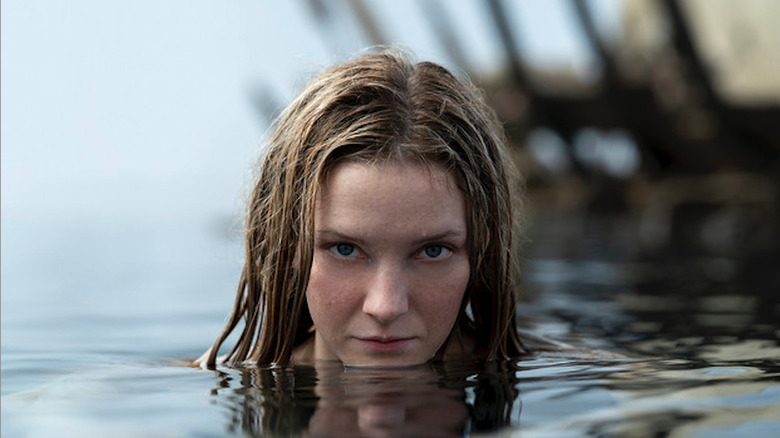Amazon's Rings Of Power Will Dive Into This Massive, Never-Before-Seen Region Of Middle-Earth
Middle-earth is a massive place. It contains larger-than-life characters, insanely epic stories, and vast landscapes ... lots of landscapes. It doesn't matter if you're talking about the lofty peaks of the Misty Mountains, the sprawling eastern lands of Rhûn, the endlessly winding Great River, Anduin, the rolling plains of Rohan, the charred remains of Mordor ... Everywhere you go in Middle-earth, there are jaw-dropping visuals to be had.
Many of these fantastical geographic locations have already been translated from book to screen. Ralph Bakshi's 1978 animated classic "The Lord of the Rings" started the trend, but it was Peter Jackson's "The Lord of the Rings" films that took things to the next level. Jackson's trilogy features countless sweeping panoramas — all filmed in his native New Zealand — that have literally taken fans' breath away for over two decades.
And yet for all the Middle-earth images Jackson has left on our collective conscious, it appears that Amazon's new "The Lord of the Rings: The Rings of Power" is going to bring its own fresh, inspired perspective to the cinematic Middle-earth landscape — and that isn't just our opinion. In an interview with Empire, concept artist John Howe stated, "This isn't the Middle-earth you remember."
Howe, who has worked on multiple Tolkien projects in the past, including serving as a conceptual designer for Peter Jackson's "Lord of the Rings" and "Hobbit" trilogies, explained that the "Rings of Power" world is "very vibrant. The elves are not hidden away in Mirkwood or lingering in Rivendell. They're busy constructing kingdoms. The dwarven kingdom of Moria is not an abandoned mine and the Grey Havens is not yet an abandoned city. I loved having the opportunity to explore that unseen history." Howe also teased a new geographic region of Middle-earth.
The Rings of Power will take to the seas
It's true that we're going to see a more vibrant Middle-earth. In the aforementioned interview, Empire pointed out that most of the areas of Middle-earth that we've seen so far have generally been mountainous, marshy, or muddy. That's because, by the time of "The Lord of the Rings," many of the most epic periods of Middle-earth history are in the past. The Dead Marshes inhabit an area that was much less creepy ... until the deadly Battle of Dagorlad destroyed it. Weathertop has the ruinous remains of a glorious tower. Even Gondor is a shadow of its former glory. All of these things are ascending rather than descending during the Second Age, when "Rings of Power" is set.
But there's more than just historical vibrancy to be had in the new series. John Howe also hints that we're finally going to get to see an area of Middle-earth that is clearly near and dear to the heart of the Elves, many Men, and even Tolkien himself: the sea.
"We're finally sailing on the oceans of Middle-earth," Howe states, confirming the long-suspected fact that "Rings of Power" will boldly go where no Middle-earth adaptation has gone before. In spite of the key role that massive bodies of water fill in Tolkien's legendarium, it's wild to note that the ocean really hasn't played any part of significance in adaptations up to this point. We catch a glimpse of the distant briny deep when Aragorn, Legolas, and Gimli confront the black ships in a scene in the extended edition of "Return of the King." We also see Frodo's ship sailing into the sea at the end of the same movie. And that's about it. But it looks like the tides are about to change.
Who could we see at sea in Rings of Power?
The fact that we'll finally see the ocean regions of Middle-earth isn't just something that's overdue. It's also loaded with potential.
For instance, the most obvious candidates for this sea-faring element of the show are the Men of Númenor. These guys literally live on an island out in the midst of Middle-earth's Belegaer (the "Great Sea" away to the left on most Middle-earth maps). They have a hefty role to play in the Second Age and are consistently making trips to and from the mainland.
But John Howe actually doesn't even mention these oceanic front-runners. He goes deeper, referencing the people who are, historically, most associated with the sea: the Elves. "They're daunting and enterprising and are almost colonising the world. They were a lot of fun to imagine. It's something neither 'Lord [o]f [t]he Rings' nor 'Hobbit' movies went anywhere near."
The idea of colonizing Elves fits well with their ambitious Second Age activities. After the destructive ending of the First Age, the Elves who remain in Middle-earth build up new kingdoms on the restructured mainland. Some of these are more inland, like the region of Eregion, where the Rings of Power are eventually forged. But others border the water, including the kingdom of Lindon, which has repeatedly been talked about as a central point in the show.
Whether it's Men or Elves, it's going to be fun to see that classic Tolkien aesthetic (which it appears the show is going to great lengths to match) at sea. It promises to provide a new, unique visual perspective of a fantasy world that just keeps on giving.


